Research Article Open Access
Optimization of Physiochemical Parameters for Decolorization of Reactive Black HFGR Using Soil Fungus, Aspergillus allhabadii MTCC 9988
| Rohilla SK1*, Salar RK1 and Kumar J2 | |
| 1Department of Biotechnology, Chaudhary Devi Lal University, Sirsa-125055, India | |
| 2Department of Molecular Biology and Biotechnology, CCS HAU, Hisar-125004, India | |
| Corresponding Author : | Rohilla SK Department of Biotechnology, Chaudhary Devi Lal University Sirsa-125055, India Tel: +91-9416182296 E-mail: rohillasuresh@gmail.com |
| Received March 27, 2012; Accepted May 18, 2012; Published May 20, 2012 | |
| Citation: Rohilla SK, Salar RK, Kumar J (2012) Optimization of Physiochemical Parameters for Decolorization of Reactive Black HFGR Using Soil Fungus, Aspergillus allhabadii MTCC 9988. J Bioremed Biodeg 3:153. doi: 10.4172/2155-6199.1000153 | |
| Copyright: © 2012 Rohilla SK, et al. This is an open-a ccess article distributed under the terms of the Creative Commons Attribution License, which permits unrestricted use, distribution, and reproduction in any medium, provided the original author and source are credited. | |
Related article at Pubmed Pubmed  Scholar Google Scholar Google |
|
Visit for more related articles at Journal of Bioremediation & Biodegradation
Abstract
Aspergillus allhabadii MTCC 9988 isolated from pesticides sprayed cotton growing soil, were evaluated for decolorization of a textile dye, Reactive Black HFGR. The physiochemical parameters (shaking vs. static, pH, temperature, dye concentration and different carbon sources) were optimized and tested their effect on the degradation of textile dye in C-limited Czapek Dox media. Aspergillus allhabadii MTCC 9988 showed highest decolorization (90.57 ± 0.33%) of textile dye in shaking condition at temperature (30°C), pH (5.0), dye concentration (150 mg/L) and glucose as carbon source. Effect of different concentration of Reactive Black HFGR dyes ranging from 50 to 250 mg/L had a significant effect on decolorization (68.99 ± 0.67 to 90.57 ± 0.33%) with maximum decolorization at 150 mg/L and further increase in the concentration of dye showed a negative effect on the decolorization of the tested fungal strain. Different pH, ranging from 4 to 8 and temperatures ranging from 20-40°C also affected the decolorization efficiency of the tested fungal strain. However, optimum pH and temperature was found to be 5 and 30°C respectively. There was an influence of carbon source on decolorization, as the fungus showed considerable variation in decolorization activity in various carbon supplemented medium. The fungal strain showed maximum decolorization activity with glucose (90.57 ± 0.33%), followed by fructose (87.22 ± 0.22%) and sucrose (74.06 ± 0.55%). Therefore, bioaugmentation is also an excellent approach for dye degradation from the effluent and it might be a practical alternative in the dyeing wastewater treatment
| Keywords | ||||||||||||||||||
| Aspergillus allhabadii MTCC 9988; Bioaugmentation; Decolorization; Physiochemical; Reactive Black HFGR | ||||||||||||||||||
| Introduction | ||||||||||||||||||
| Dyes are intensely colored organic compounds having widespread applications; in textile industries for dyeing nylon, polyacylonitrile, modified nylon, wool, silk, cotton etc. Over 10,000 dyes with an annual production of over 7×105 metric tons are commercially available [1]. Approximately 50% of these dyes are released in the industrial effluents [2]. It is estimated that 10-70 L of water is required for processing one meter of cloth and that produces about 20-30 mgL-1 of BOD (Biochemical Oxygen Demand). An industry having production capacity of approximately 35,000 md-1 consumes 1000 KL water d-1 and about 800 KL dyes containing effluent d-1 [3]. Dyes are designed in such a way that they are resistant to light, water and oxidizing agents and, therefore, these dyes cannot be treated by conventional treatment processes such as an activated sludge [4]. Dye colors are visible in water concentration as low as 1 mg/l, whereas textile processing waste water normally contains more than 10-200 mg/l of dye [5]. | ||||||||||||||||||
| A major environmental problem facing the textile dyeing industry is that the industry produces large volumes of high strength aqueous waste continuously. Wastewater containing recalcitrant residues into rivers and lakes lead to higher biological oxygen demand posing a serious threat to native aquatic life [6] and have toxic and carcinogenic effect in mammals [7]. | ||||||||||||||||||
| The problem of environmental pollution is increasing day by day due to the release of xenobiotic substances into water, soil and air. These substances include organic compounds (pesticides, dyes, polymers etc.) and heavy metal ions. The damage caused by these pollutants to plants, animals and humans cannot be neglected and hence strategies must be developed to solve the problem of environmental pollution on the priority basis. Removal of dyes from the effluents or their degradation before discharge is a great environmental challenge for the industries [8]. | ||||||||||||||||||
| Generally used physiochemical methods adsorption, floatation, coagulation, incineration, neutralization, reduction, oxidation, electrolysis and ion-exchange; are effective and efficiently remove dyes from the effluents but produced large sludge and by products which are more toxic. Biological processes like aerobic, anaerobic and bioaugmentation and biostimulation are getting more attention as they are cost effective, easy to use, ecofriendly and convert organic compounds completely into water and carbon dioxide [9]. Microbial communities are of primary importance in degradation of dye contaminated soils and water, as microorganisms alters to dye chemistry and mobility through reduction, accumulation, mobilization and immobilization. A number of biotechnological approaches have been suggested as of potential interest towards combating this pollution source in an eco-efficient manner by use of bacteria, fungi and algae for various bioremediation processes. | ||||||||||||||||||
| Keeping in view the above points, the present study was undertaken to optimize various parameters and evaluate the potential of an ascomycete, Aspergillus allhabadii MTCC 9988 for the removal of a dye, Reactive Black HFGR from aqueous solution. | ||||||||||||||||||
| Materials and Methods | ||||||||||||||||||
| Sampling | ||||||||||||||||||
| Soil samples used for the isolation of fungi were collected in sterile Polyethylene zipper bags from the agricultural soils having history of repeated pesticides application. The samples were brought to the laboratory and stored at 4°C before processing. | ||||||||||||||||||
| Media and chemicals | ||||||||||||||||||
| All media components and chemicals used in the present study were of analytical grade and purchased from Hi-Media Laboratories (Mumbai, India). The textile dyes, Reactive Black HFGR used for decolorization study was a gift from M/s Mayur Paliwal Textiles, Panipat (Haryana). The property wise data of the dye are as given below and structural formula for Reactive Black HFGR is shown in (Figure 1). | ||||||||||||||||||
|
||||||||||||||||||
| Isolation and characterization of fungi | ||||||||||||||||||
| Serial dilution agar plating method was employed for the isolation of soil microbes; the suspension was diluted up to 10-5. The aliquots were cultured for fungus on Czapek Dox Agar (NaNO3 2.0 g, KCl 0.5 g, K2 HPO4 1.0 g, MgSO4 .7H2O 0.5 g, FeSO4. 7H2O 0.01 g,); and Potato Dextrose Agar (Peeled potato - 200.0 g, Dextrose - 20.0g) media. For primary isolation, Rose Bengal (30mg/L) was also added to the medium. Three plates were incubated for 24-96 hrs at 25 ± 2°C, and morphologically unique fungi were sub-cultured and purified using standard techniques. | ||||||||||||||||||
| The fungi were identified and characterized based on their morphological characters and microscopic analysis by [10-13] using taxonomic guides and standard procedures. The following morphological characteristics were evaluated: colony growth (length and width), presence or absence of aerial mycelium, colony color, presence of wrinkles and furrows, pigment production etc. The identified fungal strains were preserved on CDA slants at 4°C in a refrigerator and served as stock cultures. Subcultures were routinely made after every month. | ||||||||||||||||||
| Decolorization assay | ||||||||||||||||||
| The decolorization ability was initially screened on a solid plate supplemented with dye, Reactive Black HFGR (150 mg/L). For each plate, a disc of inoculum was placed at the center, and uninoculated plate was maintained as a control. The plates were incubated at 25 ± 2°C and observed for decolorization over a period of 5 days [14]. Further, screening was carried out in the liquid C-limited Czapek-Dox medium (100 ml) with dye (150 mg/L); subsequently inoculated with 8 mm disc of the fungal strain. Agitated cultures of fungal species were grown for 10 days in an incubator shaker at 30 ± 2°C and 120 rpm. Samples were withdrawn aseptically on alternate days, centrifuged at 5000 rpm for 10 min and the supernatant was scanned in spectrophotometer and Nano Drop 2000c at λmax (594 nm) of the dye. Two control flasks were maintained viz., one flask contained medium (without dye) and inoculated fungal biomass and second flask contained medium with dye no fungal biomass. Percent decolorization was calculated using the formula [15]. | ||||||||||||||||||
 |
||||||||||||||||||
| Where, A0 is the initial absorbance of sample and At is the absorbance at different time intervals. | ||||||||||||||||||
| Optimization of physico-chemical parameters for decolorization | ||||||||||||||||||
| Physiochemical parameters such as carbon sources (glucose, fructose and sucrose) static vs. shaking conditions, pH (4.0-8.0), temperature (20-40°C) and dye concentration (50, 100, 150, 200, 250 mg/L) in the aqueous medium were studied. The Decolorization efficiency of Aspergillus allhabadii at various pH and temperature studied with different carbon source and changing dye concentration were tested and the optimum parameters were found to be pH-5, temperature 30°C, glucose (5 g/L) and dye concentration (150 mg/L) were optimized. Based on the observations, acidic pH 5, temperature 30°C, glucose as carbon source and dye at 150 mg/L was preferred to study the potential of the fungus in a decolorization method. | ||||||||||||||||||
| Statistical analysis | ||||||||||||||||||
| All analysis was conducted in duplicate and results presented here are the mean of duplicate ± standard deviations (SD). | ||||||||||||||||||
| Results and Discussion | ||||||||||||||||||
| Isolation and characterization of fungal strain | ||||||||||||||||||
| The fungal isolate was obtained in pure culture by using standard techniques. The fungal isolate was identified with the help of photomicrograph taken. The isolate from agricultural soil was identified as Aspergillus allhabadii, filamentous fungus belonging to the phyla Ascomycota. The key features of the fungus were: Colonies on CZA grow rather restrictedly with loose aerial hyphae, at first white becoming glaucous-blue conidia heads, radiate, becoming definitely columnar, vesicles ovoid, sterigmata in two series, conidia globose, smooth – walled, colonies in white heads but appearing pale blue green in mass. The cultural and sporulating structure of the isolates was shown in (Figure 2). Further, the fungus was deposited to IMTECH (Chandigarh) for the identification and characterization and they confirmed the identity of the fungus with MTCC number, Aspergillus allhabadii MTCC 9988. Aspergillus species are well adapted to polluted soil and water and are frequently isolated from effluents and dye contaminated soils [3,9]. | ||||||||||||||||||
| Decolorization assay | ||||||||||||||||||
| The textile and dyeing industry are one of the industries, which contribute to the soil and water pollution. In the present research work the potential of an ascomycete, Aspergillus allhabadii for the removal of a dye, Reactive Black HFGR was studied. Fungal strain was initially screened for their growth and decolorization with Reactive Black HFGR dyes (150 mg/L) on Czapek Dox Agar media (CDA). In solid plate screening tests, a zone of disappearance of dye around the fungal biomass confirmed the dye decolorizing activity of the tested fungal strains as shown in (Figure 3). Decolorization efficacy has been reported during the growth of the fungi on solid media [16-18]. The results are in accordance with an earlier report of the screening of fungi and bacteria on solid media showing growth and decolorization on solid culture [19]. Further, Aspergillus allhabadii was tested for their ability to decolorize reactive black was carried out in liquid media and the decolorization efficacy was based on changes in their optical density. | ||||||||||||||||||
| Optimization of dye decolorization | ||||||||||||||||||
| For the maximization of decolourization of the textile dye (Reactive Black HFGR) by the selected fungal isolates, experiments were conducted for optimization of the carbon source, pH, temperature and dye concentration. The effects of studying parameters on decolorization were also tested in the present study. | ||||||||||||||||||
| Effect of static/shaking on decolorization | ||||||||||||||||||
| The decolorization process was carried out using shaking (120 rpm) and static culture inoculated with fungal disc (8 mm) from fungal colony growing on a CDA plate in Erlenmeyer flasks (250 ml) containing sterilized liquid dye (100 ml) containing medium and incubated in an incubator at 25 ± 2°C for ten days. It was found that the fungus was more efficient in decolorization in shaking condition (90.57 ± 0.33%) than static (76.71 ± 0.55%). (Figure 4) clearly indicating that the shaking condition had improved the rate of percent decolorization. The extent of percent decolorization may be increased by treatment under shaking conditions because shaking facilitates the transfer and distribution of nutrients and oxygen between the medium and the microbial cells [20]. | ||||||||||||||||||
| Effect of pH on decolorization | ||||||||||||||||||
| The effect of initial pH (4.0-8.0) was investigated and found that the highest percent color removal was determined at acidic pH 5 (90.57 ± 0.33%) when compared to neutral and basic pH 8 (Figure 5). The optimum pH was found 5.0 for maximum removal of dye. The pH has a considerable effect on the efficiency of dye decolorization, and the optimal pH for color removal is often between 4.5 to 11.5 for most of the dyes and reported sharp changes in decolorization towards both ends of the optimum pH values [19,21]. Higher uptake obtains at lower pH value may be due to the electrostatic attraction between negatively charged dye anions and positively charged cell surface. These results provided an information that acidic pH is required for growth and decolorization. | ||||||||||||||||||
| Effect of incubation temperature on decolorization | ||||||||||||||||||
| Different temperatures used were ranging between 20-40°C. The maximum decolorization was observed at 30°C (90.57 ± 0.33%) followed by 25°C (85.20 ± 0.44%) and 35°C (81.61 ± 0.22%) as shown in (Figure 6). Remazole Black B was decolorized with mix culture with an optimum decolorizing temperature of 30°C [22]. This may be owing to a greater production of enzymes and optimal growth conditions of the isolate for its dye decolorizing ability. The decolourization at this optimum temperature may be owing to higher respiration and substrate metabolism. The decolourization of the dye may be through microbial reaction which relies on optimal temperature and not by adsorption [23,24]. Hence pH and temperature optimum for Reactive Black HFGR was found to be pH 5 and 30°C respectively. | ||||||||||||||||||
| Effect of dye concentration on decolorization | ||||||||||||||||||
| The actual concentration of color compounds found in the effluents has been reported to range from 12 to 16 mg/L. In the present study effects of varying concentration of dye (50-300 mg/L) on decolorization was also investigated. The Decolorization efficiency of the fungus was found to be higher (90.57 ± 0.33%) with 150 mg/L under shaking condition (Figure 7) at 30°C with glucose used as carbon source. In addition, growth of the fungus was strongly inhibited at dye concentration above 200 mg/L, as a higher concentration of dye may be toxic to metabolic activities. Similar finding has been observed that an elevated concentration of dyes is found to be growth limiting [25]. The desorption of the dyes from the fungal cells especially at higher dye concentrations may be due to higher molecular mass, structural complexity and the presence of inhibitory groups, SO3Na in the dyes [26]. | ||||||||||||||||||
| Effect of carbon source on decolorization | ||||||||||||||||||
| Three carbon sources such as glucose, fructose and sucrose were used at 5 g/L. The range of activity on decolorization of Reactive Black HFGR with glucose was the highest (90.57 ± 0.33%), followed by fructose (87.22 ± 0.22%) and sucrose (74.06 ± 0.55%) after ten days of incubation in shaking condition (Figure 8). Growth media may be enhancing the adsorption/degradation capacities of fungi and on the addition of carbon and other nutrient increased decolorization up to 92.9% in a short time [27]. Decolorization of dye involved adsorption of the dye compound at the initial stage followed by the decolorization through microbial metabolism [28,29]. Microorganisms are used for decolorization of dyes and effluents and the fungal biomass proved to be more efficient [30]. Rapid growth of the fungus in C-limited medium with dye indicated that the fungus utilized the dye as the sole source of carbon and produced enzymes to degrade the dyes. No dye decolorization was observed in the control flask without inoculum. | ||||||||||||||||||
| Conclusion | ||||||||||||||||||
| Although decolorization is a challenging process to both the textile industry and the wastewater treatment, the results of this finding suggest a great potential of fungi to be used to remove color from dye waste waters. The textile dye (Reactive Black HFGR) is degradable under aerobic conditions with a concerted effort of fungus isolated from pesticides sprayed cotton growing soil. Physiochemical parameters (pH, temperature, carbon source, dye concentration and agitation) had a significant effect on dye decolorization. Finally, bioaugmentation is also an excellent approach for removing color from the effluent and it might be a practical alternative in the dyeing wastewater treatment. | ||||||||||||||||||
| Acknowledgements | ||||||||||||||||||
| The authors are thankful to the Chairperson, Department of Biotechnology, Ch. Devi Lal University, Sirsa for providing necessary laboratory facilities to carry out the present research work and M/s Mayur Paliwal Textiles, Panipat (Haryana) for providing the dye and necessary information about it. | ||||||||||||||||||
References
|
Figures at a glance
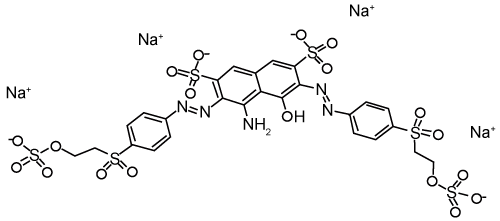 |
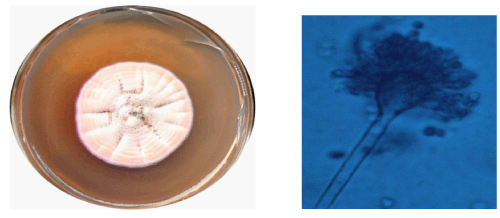 |
 |
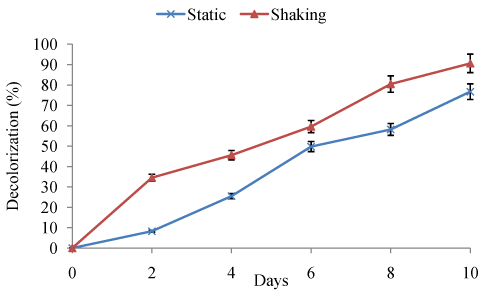 |
| Figure 1 | Figure 2 | Figure 3 | Figure 4 |
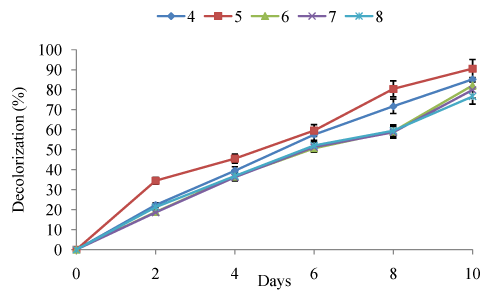 |
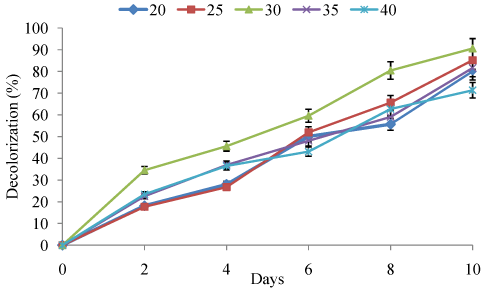 |
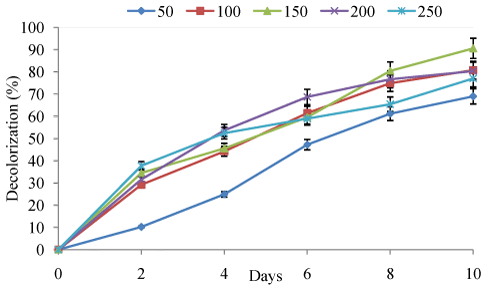 |
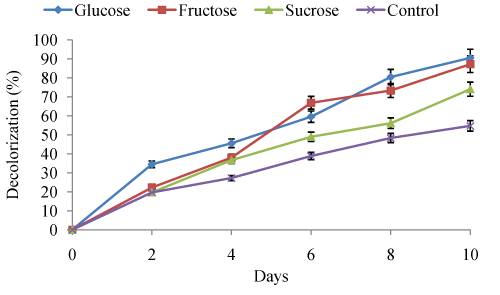 |
| Figure 5 | Figure 6 | Figure 7 | Figure 8 |
Relevant Topics
- Anaerobic Biodegradation
- Biodegradable Balloons
- Biodegradable Confetti
- Biodegradable Diapers
- Biodegradable Plastics
- Biodegradable Sunscreen
- Biodegradation
- Bioremediation Bacteria
- Bioremediation Oil Spills
- Bioremediation Plants
- Bioremediation Products
- Ex Situ Bioremediation
- Heavy Metal Bioremediation
- In Situ Bioremediation
- Mycoremediation
- Non Biodegradable
- Phytoremediation
- Sewage Water Treatment
- Soil Bioremediation
- Types of Upwelling
- Waste Degredation
- Xenobiotics
Recommended Journals
Article Tools
Article Usage
- Total views: 14226
- [From(publication date):
June-2012 - Nov 22, 2025] - Breakdown by view type
- HTML page views : 9464
- PDF downloads : 4762
